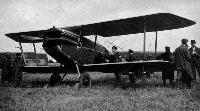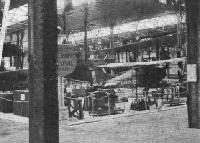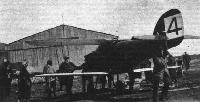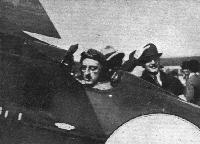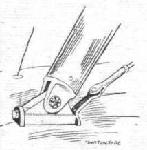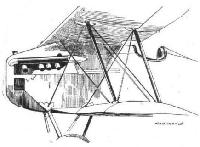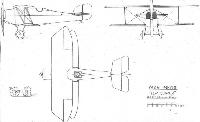
Описание
Страна : Великобритания
Год : 1918
Одноместный истребитель
Варианты
- Martinsyde - F.3 / F.4 Buzzard - 1918 - Великобритания
- Martinsyde - F.4A / F.6 / A - 1919 - Великобритания
- Martinsyde - A.D.C.1 / Nimbus - 1924 - Великобритания
Martinsyde. Серия F
<...>
Одноместный F.3 представлял собой уменьшенный вариант самолета F.2. Пилот размещался в открытой кабине сразу за крылом, в верхнем крыле для лучшего обзора из кабины сделали большой вырез. Аэродинамику самолета улучшили, установили экспериментальный мотор Rolls-Royce Falcon мощностью 285 л. с. Вооружение состояло из двух синхронных неподвижных пулеметов.
На официальных испытаниях самолет продемонстрировал чрезвычайно высокие для того периода времени данные, и было заказано шесть F.3 с мотором Rolls-Royce Falcon III мощностью 275 л.с. Фактически они являлись предсерийными машинами для F.4 Buzzard , который не сильно отличался от них. На этом самолете кабину летчика сместили назад и установили более мощный мотор Hispano-Suiza. Первоначально была заказана большая партия F.4, но всего 60 истребителей закупили для вооружения британских ВВС в конце Первой мировой войны. У компании "Martinsyde" скопилось порядка 200 построенных самолетов, часть из которых удалось продать ВВС других стран, а часть переоборудовали для гражданского использования.
Варианты
A.D.C.1: вариант, разработанный компанией "Aircraft Disposal Company" после ликвидации "Martinsyde" в 1921 году; отличался главным образом мотором Armstrong Siddeley Jaguar мощностью 395 л.с.
Nimbus Martinsyde: один самолет, конвертированный "A.D.C." под установку мотора A.D.C. Nimbus мощностью 300 л. с.
<...>
ТАКТИКО-ТЕХНИЧЕСКИЕ ХАРАКТЕРИСТИКИ
Martinsyde F.4
Тип: одноместный истребитель
Силовая установка: один мотор Hispano-Suiza V-8 мощностью 300 л. с. (224 кВт)
Летные характеристики: макс. скорость на уровне моря 108 км/ч; практический потолок 7620 м; продолжительность полета 2 ч 30 мин
Масса: пустого 776 кг; максимальная взлетная 1038 кг
Размеры: размах 9,99 м; длина 7,77 м; высота 3,15 м; площадь крыльев 29,73 м2
Вооружение: два синхронных 7,7-мм пулемета Vickers
Описание:
- Martinsyde. Серия F
- Flight, June 1920
THE MARTINSYDE MACHINES - Flight, July 1920
The Olympia Aero Show 1920 - Flight, October 1921
THE "ALULA" WING DEMONSTRATED
Фотографии
-
Aeroplane Monthly 1986-05 / Martinsyde F.4 Buzzard MA-24 /Preservation Profile/
Регистрационный номер: MA-24 [5] -
Air International 1985-12 / Fighter A to Z
The Falcon III-powered F.3 Buzzard, production of which was inhibited by priority in the Rolls-Royce engine supplies being assigned to the Bristol Fighter.
-
Flight 1920-06 / Flight
The Martinsyde F3, 190 h.p. Rolls-Royce engine
-
Flight 1920-06 / Flight
The Martinsyde F.4, 300 h.p. Hispano-Suiza engine
-
Air Pictorial 1958-01 / J.Bruce - The Martinsyde F.4 Buzzard /Aircraft of 1914-18 War/
Регистрационный номер: D4263 [2] -
Jane's All the World Aircraft 1980 / Encyclopedia of Aviation - Aircraft A-Z - v4
Регистрационный номер: D4263 [2] Martinsyde F.4 Buzzard.
-
Air Pictorial 1968-11 / B.Robertson - But for the Armistice...
Регистрационный номер: D4354 The Martinsyde F.4 Buzzard, fastest fighter of the era, was scheduled to replace the S.E.5A in service squadrons
-
Мировая Авиация 185
Хотя F.4 и превосходил по своим характеристикам Snipe, широкого распространения в истребительных частях британских ВВС этот самолет не получил.
-
Авиация и Космонавтика 2008-02 / М.Никольский - 899-й гвардейский полк
Истребитель "Мартинсайд"
-
Air International 1985-12 / Fighter A to Z
Регистрационный номер: MA-33 One of the examples of the Buzzard, the HS 8Fb-powered F.4, supplied to Finland.
-
Aeroplane Monthly 1986-05 / Martinsyde F.4 Buzzard MA-24 /Preservation Profile/
Регистрационный номер: MA-24 [5] MA-24 is currently equipped with skis originally fitted to a VL Viima biplane.
-
Aeroplane Monthly 1984-10 / Personal album
Регистрационный номер: MA-32, MA-36 Two of the 15 Martinsyde F.4 Buzzards used by the Finnish Air Force between 1923 and 1939. MA-24 is exhibited now at Tikkakoski.
-
Air Enthusiast 1998-01 / R.Niccoli - Atlantic Sentinels
A Martinsyde F.4 Buzzard of the Esquadrilha de Caca 1 at Tancos. The unit markings consist of a yellow greyhound and a red stripe on fuselage.
-
Flight 1930-01 / Flight
Typical Aerial Derby machine: Martinsyde F.4 (300 h.p. "Hispano").
-
Авиация и Космонавтика 2018-01 / В.Морозов - Авиация Литвы: 1919-2018гг. (1)
Истребители Фоккер D.VII и Мартинсайд F.4 из 1-й ИАЭ ВВС Литвы. Каунас, 1923 г.
Другие самолёты на фотографии: Fokker D.VII - Германия - 1917
-
Aeroplane Monthly 1974-09 / ??? - Hendon Pageantry 1920-37
A Martinsyde F.4 and a Fokker D.VII about to take-off for a mock dog fight.
Другие самолёты на фотографии: Fokker D.VII - Германия - 1917
-
Flight 1920-07 / Flight
R.A.F. PAGEANT: Event No. 2. A Martinsyde and a Fokker about to take off for a "scrap," and on the right, the pair in the thick of the fight above the aerodrome
Другие самолёты на фотографии: Fokker D.VII - Германия - 1917
-
Flight 1920-07 / Flight
The Martinsyde "F.4" (No. 12) passes over Hendon Aerodrome after the first lap for the Aerial Derby
-
Aeroplane Monthly 1979-10 / D.Brown - Wings over Sussex (2)
Регистрационный номер: G-EBMI [2] The ill-fated Martinsyde F.4, G-EBMI, fitted with a 300 h.p. Hispano- Suiza. It crashed at Woodley, Reading, on August 24, 1930.
-
Aeroplane Monthly 1979-10 / D.Brown - Wings over Sussex (2)
Регистрационный номер: G-EBMI [2] Another view of E. D. A. Biggs' Martinsyde, seen at Shoreham in 1930.
-
Flight 1920-07 / Flight
The Martinsyde F.4, 300 h.p. Hispano-Suiza (No. 12), piloted by Squadron Leader T. O'B. Hubbard in the Aerial Derby
-
Flight 1922-08 / Flight
THE AERIAL DERBY: Martinsyde F.4, 300 h.p. Hispano-Suiza.
-
Flight 1922-06 / Flight
RACING AT WADDON: Machines lined up for the start of First Whitsuntide Handicap.
-
Flight 1930-01 / Flight
The classic and popular air race known as the Aerial Derby, inaugurated in 1912. At the photo is the "line-up" of competing machines before the start of the fifth contest, which took place in July, 1920. The machine in the foreground is. the Nieuport "Nieuhawk" piloted by "Jimmy" James, who finished second. Next are the two Martinsydes - the F.6 and the F.4.
Другие самолёты на фотографии: Martinsyde F.4A / F.6 / A - Великобритания - 1919Nieuport & General Nighthawk - Великобритания - 1918
-
Flight 1920-07 / Flight
The Aircraft Disposal Company's Exhibit at the Aero Show, Olympia: Some "parts" and the Martinsyde F 4
-
Aeroplane Monthly 1978-05 / A.Jackson - Avro 504K /RAF Piston Trainers/ (1)
War surplus 504Ks and Martinsyde F.4s stacked in the Aircraft Disposal Company works at Croydon in 1920. E449, now in the RAF Museum, is visible as the 5th complete serial from the right Airdisco, as it was known, was a subsidiary of Handley Page Ltd.
Другие самолёты на фотографии: Avro Avro 504 - Великобритания - 1913
-
Flight 1920-07 / Flight
Регистрационный номер: G-EAPX [6] The Martinsyde "Semi-Quaver" high-speed single-seater scout
-
Flight 1920-07 / Flight
The Martinsyde "Semi-Quaver," 300 h.p. Hispano-Suiza (No. 15), piloted by Mr. F. T. Courtney in the Aerial Derby. This machine won the Derby (fastest time)
-
Flight 1920-07 / Flight
Регистрационный номер: G-EAPX [6] A RACER AT OLYMPIA: The Martinsyde "Semiquaver" which will be flown by Raynham in the Aerial Derby
-
Air-Britain Archive 1985-01
Регистрационный номер: G-EAPX [6] Our piece of kite-flying about the possible link between the Martinsyde F5 and the Semiquaver produced some photos of the Hendon 1920 Aerial Derby winner G-EAPX. It is shown being prepared for the race on 24.7.20
-
Flight 1920-10 / Flight
The Gordon-Bennett Race: Taking Raynham's Martinsyde "Semiquaver" out to the starting line
-
Flight 1920-07 / Flight
THE AERIAL DERBY: Mr. F. T. Courtney, the Derby winning pilot, who took Mr. Raynham's place in the 300 Hispano-Suiza-engined Martinsyde "Semi-Quaver.''
-
Flight 1920-07 / Flight
THE AERIAL DERBY: The "Semi-Quaver" takes off for the race;
Другие самолёты на фотографии: Avro Baby / Type 534 - Великобритания - 1919
-
Flight 1921-10 / Flight
Регистрационный номер: G-EAPX [6] THE "ALULA" WING DEMONSTRATED: Two views of the Martinsyde "Semi-quaver" fitted with an "Alula" wing, and, above, R. W. Kenworthy who flew the machine. Inset, the machine in flight.
-
Aeroplane Monthly 1986-05 / Martinsyde F.4 Buzzard MA-24 /Preservation Profile/
Регистрационный номер: MA-24 [5] The Buzzard's cockpit.
-
Aeroplane Monthly 1986-05 / Martinsyde F.4 Buzzard MA-24 /Preservation Profile/
Регистрационный номер: MA-24 [5] MA-24 photographed at Kauhava on November 24, 1930. Because of its heavy engine the Martinsyde had a tendency to nose over, which invariably resulted in a broken undercarriage.
-
Aeroplane Monthly 1986-05 / Martinsyde F.4 Buzzard MA-24 /Preservation Profile/
Регистрационный номер: MA-24 [5] The Buzzard partially dismantled after another incident.
-
Air-Britain Archive 1985-01
Регистрационный номер: G-EAPX [6] Our piece of kite-flying about the possible link between the Martinsyde F5 and the Semiquaver produced some photos of the Hendon 1920 Aerial Derby winner G-EAPX. It is shown inverted after the crash on landing at the end of the Derby.
-
Air-Britain Archive 1985-01
Регистрационный номер: G-EAPX [6] The photo shows G-EAPX hangared later, with damaged to wings and propeller.
-
Мир Авиации 2002-01 / Л.Андерссон - Шведские авиаторы в России /Имена авиации/ (2)
Авария истребителя Martinsyde. В июне 1922г. шведский корабль доставил в Петроград 20 самолетов этого типа.
-
Flight 1920-07 / Flight
SOME MARTINSYDE DETAILS: The interplane strut attachment on the "Semiquaver."
-
Flight 1920-07 / Flight
The fore part of the beautiful little Martinsyde "Semiquaver"
-
Flight 1920-07 / Flight
THE WINNER OF THE AERIAL DERBY, 1920: The Martinsyde "Semi-Quaver," 300 h.p. Hispano-Suiza engine. Plan, side and front elevations, to scale
-
Air International 1985-12 / Fighter A to Z
The general arrangement drawing depicts the definitive version of the Buzzard, the HS 8Fb-powered F.4.
- Фотографии







